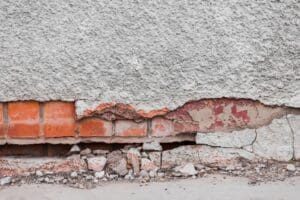- Foundation heaving occurs when soil expands and pushes the foundation upward, often due to moisture or freezing temperatures.
- Foundation settlement happens when soil compresses or erodes, causing the foundation to sink over time.
- Signs of heaving include raised or uneven floors and bowing walls, while settlement causes sinking floors and misaligned doors or windows.
- Both heaving and settlement require professional evaluation, soil stabilization, and proper drainage for repair and prevention.
- Inspections at the first sign of trouble and maintaining consistent soil moisture can help prevent future foundation issues.
Two common foundational issues are foundation heaving and foundation settlement. While both affect the foundation, they occur for different reasons and require distinct approaches for maintenance and repair.
What is Foundation Heaving?
Foundation heaving is the upward movement of a foundation due to the expansion of the soil beneath it. This movement is typically more sudden than settlement and can cause rapid structural damage.
Heaving occurs when soil beneath the foundation expands due to factors like freezing temperatures, excessive moisture, or expansive clay soils. In colder climates, frost heave can occur when moisture in the soil freezes and expands, pushing the foundation upwards. In areas with clay-rich soils, excessive moisture can cause the soil to swell, leading to foundation heaving.
Indicators of Foundation Heaving
Foundation heaving often causes sudden and noticeable damage. Here are some common signs to watch for:
- Raised or Uneven Floors: In contrast to sinking floors seen with settlement, heaving can cause parts of the floor to rise or become uneven.
- Cracks in the Foundation: As the foundation is pushed upwards, cracks may form in the slab or walls of the foundation.
- Bowing Walls: Heaving can cause walls to bow or bulge due to the upward pressure on the foundation.
Because heaving tends to cause damage rapidly, it’s important to address these signs immediately.
What is Foundation Settlement?
Foundation settlement refers to the downward movement of a foundation due to the soil beneath it compressing or eroding. This process is often slow and gradual, but if left unchecked, it can lead to significant structural problems.
Foundation settlement commonly occurs due to poor soil compaction, changes in moisture levels, or natural soil consolidation. For example, if the soil beneath the foundation was not properly compacted during construction, it can begin to compress over time, causing the foundation to settle unevenly. Additionally, changes in moisture levels—such as excessive rain or drought—can cause soil to erode or shrink, leading to further settlement.
Warning Signs of Foundation Settlement
Early detection of foundation settlement is key to preventing major damage. Homeowners should look for the following signs:
- Sinking Floors: If you notice that parts of your home’s floors are sinking or sloping, it could be due to foundation settlement.
- Cracks in Walls: Settlement can cause visible cracks in walls, especially near windows, doors, or corners of the home.
- Misaligned Doors and Windows: Doors and windows may become difficult to open or close as the foundation settles and shifts, causing misalignment.
Monitoring these signs and seeking professional help early on can prevent more serious structural issues from developing.
Solutions for Foundation Settlement and Heaving
Both foundation settlement and heaving require professional evaluation and repair, but there are steps homeowners can take to mitigate these issues:
- Soil Leveling: Soil leveling techniques, such as underpinning or injecting grout beneath the foundation, can help prevent further settlement or heaving by leveling the soil.
- Proper Drainage: Ensuring proper drainage around the home is crucial for preventing both settlement and heaving. Redirecting water away from the foundation can help control moisture levels in the soil.
- Inspections at the First Signs of Foundation Settlement and Heaving: If your home shows signs of foundation settlement and heaving, such as tilted room, cracks in the foundation or walls, or doors and windows that stick a foundation inspection can confirm the presence of settlement or heaving before they lead to major problems. Scheduling a professional assessment can key you into your foundation’s health and whether next steps need to be taken.
Preventing Future Foundation Problems
Preventing foundation issues from occurring in the first place is always the best course of action. Homeowners can take these steps to protect their foundation from future settlement or heaving:
- Maintain Consistent Soil Moisture: During dry periods, water the soil around the foundation to prevent it from shrinking and causing settlement. During wet periods, ensure proper drainage to prevent waterlogging and heaving.
- Monitor for Signs of Movement: Keep an eye on any cracks, sloping floors, or changes in the structure of your home, and act quickly if you notice something unusual.
- Consult with Professionals: Regularly consult with a foundation expert to evaluate the health of your foundation and recommend any necessary repairs or preventative measures.
Taking Action on Foundation Issues
Foundation heaving and settlement are two distinct problems that affect the stability of a home’s foundation. Heaving occurs due to upward soil expansion, while settlement results from downward soil compression. Recognizing the signs of each and taking preventative measures, such as maintaining proper drainage and seeking professional evaluations, can help homeowners protect their foundations. If you notice signs of either heaving or settlement, contact Advanced Foundation Repair to address the issue before it worsens.
